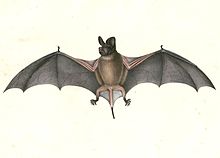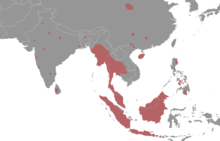| Wrinkle-lipped free-tailed bat | |
|---|---|

| |
| Conservation status | |
 Least Concern (IUCN 3.1) | |
| Scientific classification | |
| Domain: | Eukaryota |
| Kingdom: | Animalia |
| Phylum: | Chordata |
| Class: | Mammalia |
| Order: | Chiroptera |
| Family: | Molossidae |
| Genus: | Mops |
| Species: | M. plicatus |
| Binomial name | |
| Mops plicatus Buchanan, 1800 | |

| |
| Synonyms | |
| |
The wrinkle-lipped free-tailed bat (Mops plicatus) is a species of bat in the family Molossidae. It is found in Bangladesh, Bhutan, Cambodia, China, Cocos (Keeling) Islands, India, Indonesia, Laos, Malaysia, Myanmar, Nepal, the Philippines, Sri Lanka, Thailand and Vietnam.
Taxonomy and etymology
It was described as a new species in 1800 by Scottish scientist Francis Buchanan-Hamilton. Buchanan-Hamilton initially placed it into the genus Vespertilio, with the scientific name Vespertilio plicatus. Its species name "plicatus" is Latin for "folded," possibly referencing its wrinkled lips or its folded ears.
Description
Its forearm length is 40–50 mm (1.6–2.0 in). Its fur is dark brown. Its dental formula is 1.1.2.32.1.2.3 for a total of 30 teeth.
Range and habitat
Its range includes several countries and regions in South and Southeast Asia, including Cambodia, China, Hong Kong, India, Laos, Malaysia, Philippines, Sri Lanka, and Vietnam. It has been documented at elevations up to 950 m (3,120 ft).
Conservation
As of 2020, it is evaluated as a least-concern species by the IUCN—its lowest conservation priority. It met the criteria for this classification because it has a wide geographic range; its range includes protected areas, its population size is large; and it is unlikely to be experiencing rapid population decline. However, some local populations may be threatened by overharvesting for bushmeat, habitat loss via deforestation, cave disturbance, and persecution of its roosts due to the perception that it is a pest. Examples of such human interference include in northern Myanmar as a result of limestone extraction for cement manufacture and colony of hundreds of thousands of bats eradicated "as pests" in Phnom Pehn.
See also
References
- ^ Csorba, G.; Bumrungsri, S.; Francis, C.; Bates, P.; Ong, P.; Gumal, M.; Kingston, T.; Heaney, L.; Balete, D.S.; Molur, S.; Srinivasulu, C. (2020). "Chaerephon plicatus". IUCN Red List of Threatened Species. 2020: e.T4316A22018444. doi:10.2305/IUCN.UK.2020-2.RLTS.T4316A22018444.en. Retrieved 16 November 2021.
- Buchanan, Francis (1800). "XXVII. Description of the Vesperilio plicatus". Transactions of the Linnean Society of London. 5: 261–263. doi:10.1111/j.1096-3642.1800.tb00599.x.
- Smith, Andrew T.; Xie, Yan; Hoffmann, Robert S.; Lunde, Darrin; MacKinnon, John; Wilson, Don E.; Wozencraft, W. Chris, eds. (2010). A Guide to the Mammals of China. Princeton University Press. p. 352. ISBN 978-1400834112.
External links
- Article about the species (University of Bristol)
- Information about the species in Thailand (Thai National Parks)
| Taxon identifiers | |
|---|---|
| Chaerephon plicatus | |
- IUCN Red List least concern species
- Mops (bat)
- Bats of Asia
- Bats of South Asia
- Bats of Southeast Asia
- Bats of Borneo
- Bats of China
- Bats of India
- Bats of Indonesia
- Bats of Malaysia
- Bats of the Philippines
- Mammals of Bangladesh
- Mammals of Bhutan
- Mammals of Cambodia
- Mammals of Laos
- Mammals of Nepal
- Mammals of Sri Lanka
- Mammals of Thailand
- Mammals of Vietnam
- Least concern biota of Asia
- Mammals described in 1800
- Taxa named by Francis Buchanan-Hamilton